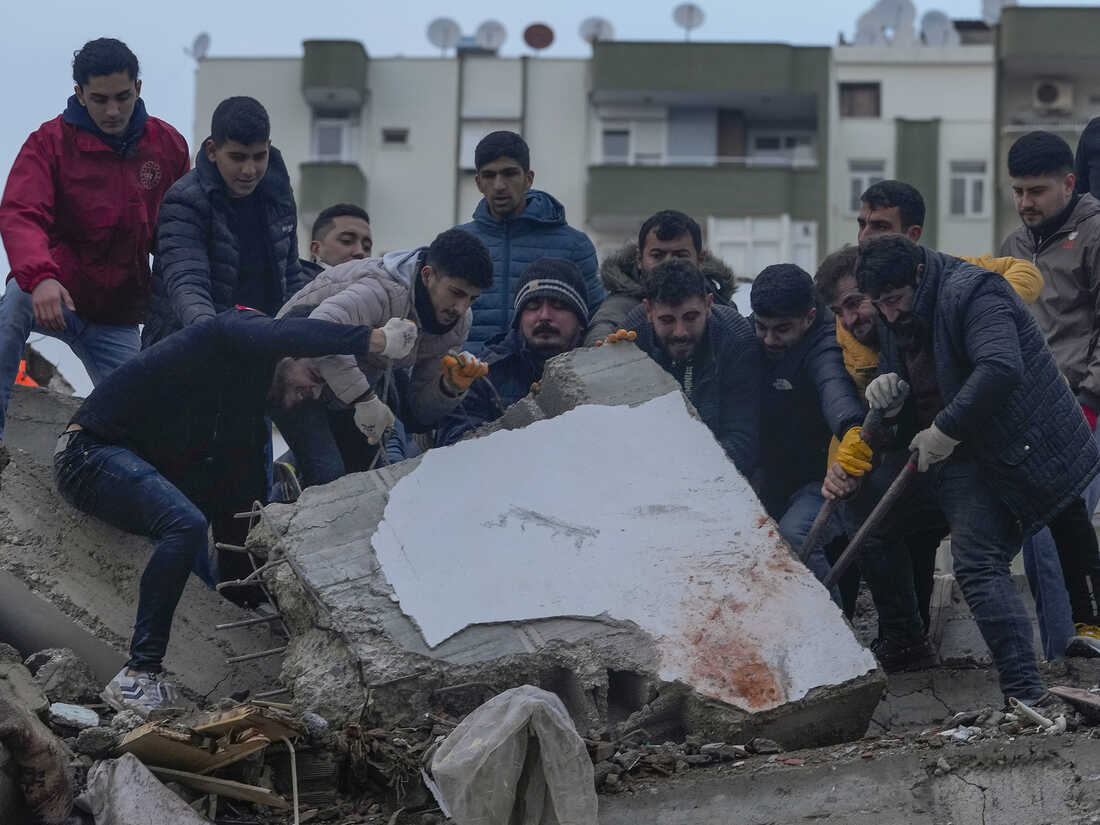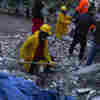Rescuers work for second day to find quake survivors as death tolls passes 5,000
Middle East
Rescuers work for second day to find quake survivors as death tolls passes 5,000

Men search for people among the debris in a destroyed building in Adana, Turkey, Monday, Feb. 6, 2023.
Khalil Hamra/AP
hide caption
toggle caption
Khalil Hamra/AP
Men search for people among the debris in a destroyed building in Adana, Turkey, Monday, Feb. 6, 2023.
Khalil Hamra/AP
ISTANBUL — Rescue workers fanned across Turkey and Syria Tuesday in a second day of work racing to find survivors from the massive earthquake and multiple aftershocks that leveled thousands of buildings across the region and sent the confirmed death toll soaring past 5,000 people.
Freezing winter temperatures and dozens of aftershocks from Monday morning’s magnitude 7.8 earthquake hampered the work to sift through the rubble of buildings and find survivors who are at risk of suffering from hypothermia as temperatures dip below 27 degrees Fahrenheit.
In the city of Adana, where at least 11 buildings had collapsed, NPR’s Ruth Sherlock stood outside a 15-story residential high-rise that had collapsed. Worried relatives watched rescue workers search for survivors under the rubble in freezing temperatures and Sherlock spoke to two elderly women and a man who were embracing each other and crying after one of their daughters had died. “She was happy,” one of them said, “We couldn’t imagine it would end like this.”
midday Tuesday, the death toll in Turkey and Syria had surpassed 5,100, including 3,419 in Turkey, with another 20,534 people injured in the country, The Associated Press reported. Another 1,602 people have been confirmed dead on the Syrian side of the border. Officials warned the toll would continue to rise; the World Health Organization said the death toll in the two countries could eventually surpass 20,000.
The quake hit at 4:17 a.m. local time in Turkey’s Gaziantep province, the U.S. Geological Survey said. It took place on the East Anatolian fault, the boundary between the Anatolian plate, the African plate and the Arabian plate of the Earth’s crust. The largest aftershock, measuring 7.5, took place nearly 100 kilometers (about 62 miles) away from the epicenter of the initial one on a different fault line.
About 13.5 million people were impacted over 10 provinces in Turkey, according to the government. More than 7,800 people in Turkey have been rescued. The government also said more than 11,000 buildings have been damaged.
Dozens of countries around the world, including the U.S., dispatched teams to assist in the rescue efforts, and Turkey’s government said more than 13,000 rescue workers had left Istanbul to help those impacted in the region by late Tuesday morning.
The toll from the quake and aftershocks devastated a region already suffering from more than a decade of civil war in Syria, a conflict that has spurred more than 3.5 million Syrian refugees into Turkey to flee war. An estimated 4.1 million people in the affected region were already receiving U.N. humanitarian assistance.
Aid groups in the region say the only crossing between Turkey and Syria approved by the U.N. for transporting international aid has been unusable since the earthquake struck, further hampering efforts.

